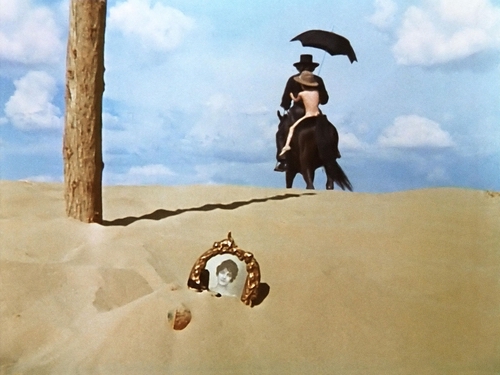
“It’s midnight mass at the Elgin. Cocteau’s Blood of a Poet has just ended, and the wait for El Topo is a brief grope for comfort before sinking back into fantastic stillness. The audience is young. They applauded Cocteau’s sanguine dream as though he were in the theater, but as credits appear on the screen, they settle again into rapt attention. They’ve come to see the light – and the screen before them is illumined by an abstract landscape of desert and sky – and the ritual begins again. Alejandro Jodorowsky rides into the picture. He is an actor and he is the director, but he directs the film from the inside: the actor becomes the director. [...] Jodorowsky is here to confess; the young audience is here for communion.
The episodes of El Topo’s progress are parabolic tales performed in concrete poetry. Many of these tales are metaphysical gags in the manner of the Marx Brothers, who often used a Sufi parable to launch their excursions into madness. Their style is often considered frivolous but is one of deliberate anarchy, which Artaud called their ‘disintegration of the real by poetry.’ The same sense of humor, rooted at the cruel basis of laughter, is present in El Topo. Its humor attacks reality, creating a comedy that provokes laughter in order to overcome horror – a comedy that becomes a cult of salvation. Its tone portrays the growth of horror among us. Despite the nostalgic trend in style, this is not the 1930s, and the price of exorcism and the price of initiation have gone up. As was declared in Jean-Luc Godard's Weekend, ‘It will take more horror to overcome the horror of the bourgeoisie.’ El Topo is dedicated to the metaphysical mechanics of that proposition.”
Glenn O'Brien1
“The genesis of El Topo lies in the transgressive art of director, theatre-maker, comic-book writer and puppeteer Jodorowsky. Much of Jodorowsky's work is influenced by Friedrich Nietzsche's and Antonin Artaud's ideas about the liberating powers of violence. With Fernando Arrabal and Roland Topor, Jodorowsky formed a group called the ‘Panic Movement’ in 1963, which embraced irrationality, mysticism and absurdity, and staged controversial plays and happenings. For Jodorowsky, art should assault the spectator with chaotic acts and symbols that bypass rational levels of meaning and connect the viewer in a more visceral, mystical manner. This philosophy fed into his first feature film, Fando y Lis (1968), which was promptly banned. Jodorowsky took his next film El Topo to the US to help it avoid the same fate. [...] El Topo's significance lies in how it captured an oppositional zeitgeist, how its metaphors brought the upheaval of the late 60s from the streets into the theatres at a time when actual political action retreated into sectarianism – a cyclical process that is neatly mirrored in El Topo's own quest.”
Ernest Mathijs2
“Although hip film buffs objected to El Topo's graceless amalgam of Luis Buñuel, Federico Fellini, Sergio Leone, Sam Peckinpah and Jean-Luc Godard, the movie bypassed cinematic sophistication to adress the counterculture directly. More than any other film, El Topo presented itself as a spiritual initiation (if not a kind of Dionysian bloodbath), speaking at once to the counterculture's love of the arcane and its collective paranoia. By 1971, the counterculture had lost the euphoria of the late sixties and was beginning to experience a dissolution into the sullen privatism of the 1970s. In this light, the messianic revenge fantasy that El Topo offered was a complex one – directed against both an evil social order and a faltering spiritual authority.”
J. Hoberman and Jonathan Rosenbaum3

